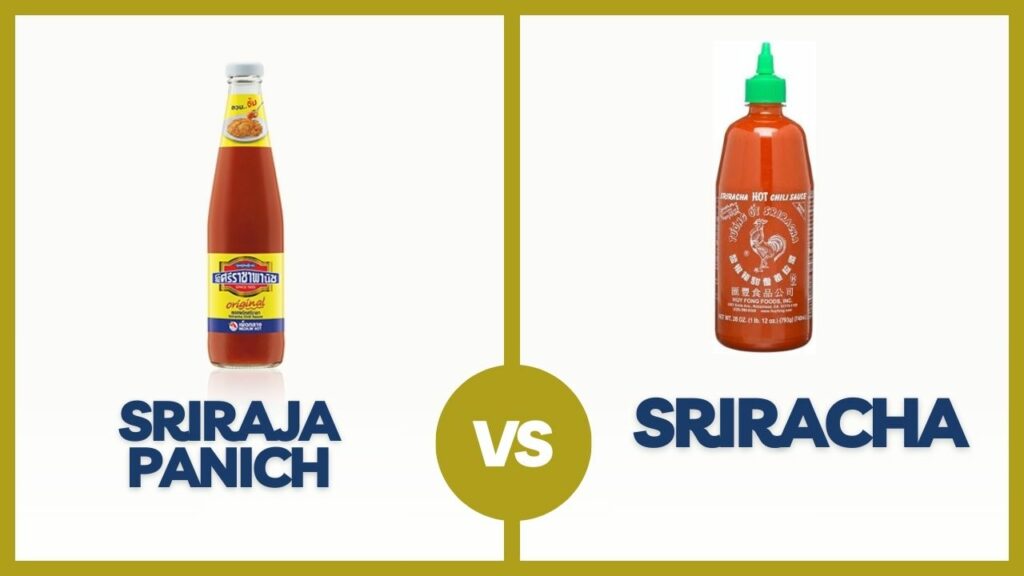When it comes to hot sauces, Sriraja Panich and Huy Fong Sriracha are two of the popular ones out there.
Originating from Thailand, these sauces have distinctive flavor profiles and versatile usability in various dishes.
But how do they differ, and more importantly, which one should you reach for to spice up your meals?
This article aims to provide a comprehensive comparison between Sriraja Panich and Huy Fong Sriracha, exploring everything from their origins and ingredients to taste, heat levels, and dietary suitability.

What Is it and Who Founded It,: Sriraja Panich vs Huy Fong Sriracha
Sriraja Panich is a Thai chili sauce produced by Thaitheparos Public Company Limited, based in Samut Prakan Province, Thailand.
The original recipe for this sauce is 80 years old and was first created by Gimsua Timkrajang. However, the credit for its invention is often attributed to Ms. Thanom Chakkapak.
The company produces three varieties: Sriraja Panich Chili Sauce Strong Hot, the spiciest version; Sriraja Panich Chili Sauce Medium Hot, a moderately spiced variant; and Sriraja Yellow Chili Sauce, made from yellow chilies.
On the other hand, Huy Fong Sriracha is an American hot sauce created by Vietnamese immigrant David Tran in 1980.
Named after the ship on which Tran escaped Vietnam, the “Huey Fong”, this popular version of sriracha has become almost synonymous with the term ‘Sriracha’ in many western countries – so much so that it’s often referred to as “rooster sauce,” a nod to the rooster logo on its bottles.
Despite its ubiquity in Western culture, Huy Fong’s recipe differs significantly from traditional Thai sriracha sauces like Sriraja Panich.
What Does It Contain: Sriraja Panich vs Huy Fong Sriracha
When it comes to the ingredients, both Sriraja Panich and Huy Fong Sriracha share some common components, but they also have significant differences that impact their flavor profiles.
Sriraja Panich is made using Spur chili, water, sugar, garlic, salt, and acetic acid. A standout feature is that it contains no preservatives. This Thai chili sauce prides itself on keeping true to traditional recipes and preserving authentic Thai flavors.
On the other hand, Huy Fong Sriracha’s ingredient list includes chili, sugar, salt, garlic, distilled vinegar, potassium sorbate (a preservative), sodium bisulfite (as a preservative), and xanthan gum (a stabilizer). One of the most notable differences is in the type of sugar used in Huy Fong Sriracha.
The sauce uses sugar refined with bone char – a substance made by burning animal bones used to filter and whiten sugar. While this might seem like a small detail, it has significant implications for those following vegan or vegetarian lifestyles as the process of refining sugar with bone char may not align with their dietary principles.
Which Taste Better: Sriraja Panich vs Huy Fong Sriracha
The definition of “better” can vary significantly depending on individual taste preference. However, let’s examine the distinct flavor profiles of Sriraja Panich and Huy Fong Sriracha.
Sriraja Panich sauce is renowned for its balanced flavor that won’t overpower the taste of a dish. It features a more pronounced garlic flavor compared to Huy Fong Sriracha – affectionately known as Rooster Sauce – and is generally less spicy. This can be preferable for those who want a hint of heat without it overwhelming the other flavors in their meal.
On the other hand, Huy Fong Sriracha offers a robust, fiery flavor profile that can add considerable depth to dishes. Its pronounced chili hit may appeal to those who love their meals extra spicy. Moreover, Huy Fong Sriracha’s sharper vinegar note could be a plus for anyone seeking that tanginess in their hot sauce.
Ultimately, the choice between these two sauces might just come down to personal preference for either a more balanced or more intense flavor.
Which Is Spicer: Sriraja Panich vs Huy Fong Sriracha
When comparing the heat levels of these two hot sauces, Huy Fong Sriracha typically comes out on top as the spicier option. This American take on the Thai sauce has a reputation for packing a significant punch, making it a go-to choice for those who prefer their food with an intense kick.
On the other hand, Sriraja Panich, whilst still offering that trademark chili heat, is usually considered less spicy than its Huy Fong counterpart.
The sauce’s heat level can vary between their three varieties – “Sriraja Panich Chili Sauce Strong Hot” being the spiciest version.
However, even their hottest option is often described as having a more balanced and subdued spice level compared to Huy Fong Sriracha.
Again, much like flavor preferences, what is deemed ‘better’ when it comes to spice levels is subjective and dependent on individual spice tolerance and preference.
Is It Gluten Free, Halal, Vegan and Whole 360: Sriraja Panich vs Huy Fong Sriracha
The dietary suitability of a product is an important consideration for many people. When comparing Sriraja Panich to Huy Fong Sriracha in this regard, there are some significant differences.
Sriraja Panich, given its simple ingredient list of Spur chili, water, sugar, garlic, salt, and acetic acid does not contain any gluten-based ingredients.
However, without specific certification from the manufacturer, it cannot be guaranteed gluten-free due to potential cross-contamination during production.
As for being vegan and Halal-compliant, while the ingredients do not appear to contain any animal products or non-Halal items, again without specific certification it’s difficult to confirm. For Whole30 compliance – a diet plan that eliminates sugars among other things – the presence of sugar could potentially make it unsuitable.
On the other hand, Huy Fong Sriracha can raise certain dietary concerns. For vegans and vegetarians specifically due to the use of sugar refined with bone char in its preparation process.
This is considered non-vegan and non-vegetarian as it involves animal exploitation. Like Sriraja Panich, without specific gluten-free or Halal certifications from the manufacturer these claims cannot be confirmed beyond doubt. And again similarly for Whole30 compliance – due to its sugar content – it may not meet the strict guidelines of this particular diet plan.
In both cases to ensure compliance with specific dietary needs or restrictions it would be advisable to consult directly with the respective manufacturers or seek out products that have been officially certified as compliant with your required diet standards.
Resource:

